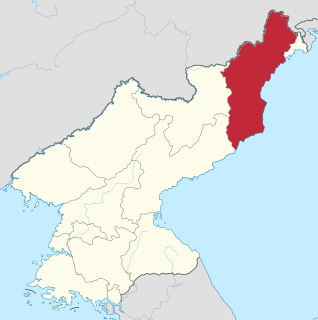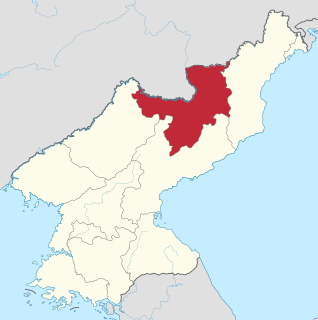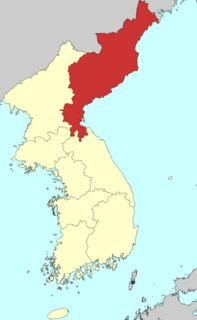
South Hamgyong Province is a province of North Korea. The province was formed in 1896 from the southern half of the former Hamgyong Province, remained a province of Korea until 1945, then became a province of North Korea. Its capital is Hamhung.

North Hamgyong Province is the northernmost province of North Korea. The province was formed in 1896 from the northern half of the former Hamgyong Province.

Ryanggang Province is a province in North Korea. The province is bordered by China (Jilin) on the north, North Hamgyong on the east, South Hamgyong on the south, and Chagang on the west. Ryanggang was formed in 1954, when it was separated from South Hamgyŏng. The provincial capital is Hyesan. In South Korean usage, "Ryanggang" is spelled and pronounced as "Yanggang"

Hamgyong Province was one of the Eight Provinces of Korea during the Joseon Dynasty. Hamgyŏng was located in the northeast of Korea. The provincial capital was Hamhŭng.

A number of Korean dialects are spoken in the Korean Peninsula. The peninsula is extremely mountainous and each dialect's "territory" corresponds closely to the natural boundaries between different geographical regions of Korea. Most of the dialects are named for one of the traditional Eight Provinces of Korea. One is sufficiently distinct from the others to be considered a separate language, the Jeju language.

Hamhŭng is North Korea's second largest city, and the capital of South Hamgyŏng Province. In late 2005, nearby Hŭngnam was made a ward (kuyŏk) within Hamhŭng-si. It has a population of 768,551 as of 2008.
Kwanbuk is a region in North Hamgyong and South Hamgyong Provinces of North Korea. The region may once have been occupied by the Okjeo people. It was later controlled by Goguryeo and then Balhae, and subsequently contested by Goryeo and the Jin dynasty.
North Korea's defense industry predates the Korean War, but has emerged as major a supplier to the North Korean armed forces beginning in the 1970s, but increasingly so after the fall of the Soviet Union and to supplement those purchased from China. Most equipment produced are copies of Soviet and Chinese built military hardware.

Kilju, sometimes romanized as Kilchu, is a county in North Hamgyong province, North Korea. The county seat is Kilju Town.
Hongwŏn County is a county in South Hamgyŏng province, North Korea. It is flanked by the Sea of Japan to the south, and by the Hamgyŏng Mountains to the north.

Kimhyŏnggwŏn County is a kun, or county, in southeastern Ryanggang province, North Korea. It borders South Hamgyŏng to the south. Previously known as Pungsan, it was renamed by Kim Il Sung in 1990. He named it after his uncle, Kim Hyŏng-gwŏn. It is known for its striking scenery and for the Pungsan Dog, a large breed of hunting dog.

Provinces are the first-level division within North Korea. There are 9 provinces in North Korea:
Chagang, North Hamgyong, South Hamgyong, North Hwanghae, South Hwanghae, Kangwon, North Pyongan, South Pyongan and Ryanggang.

Hamhŭng Station is a railway station in Yŏkchŏn 1-dong, Sŏngch'ŏngang-guyŏk, Hamhŭng city, South Hamgyŏng province, North Korea, located on the P'yŏngra Line of the Korean State Railway; it is also the starting point of the Sinhŭng Line and the Sŏho Line. A locomotive depot is located here, and there are spurs to the Hamhŭng Knitwear Factory and the Paekkŭmsan Combined Foodstuffs Factory in Haebit-tong, Sŏngch'ŏngang-guyŏk.

"South Hamgyeong Province" or "Hamgyeongnam-do" is, according to South Korean law, a province of the Republic of Korea, as the South Korean government formally claims to be the legitimate government of whole of Korea. The area constituting the province is under the de facto jurisdiction of North Korea and China.
Ch'ŏnt'an Station is a railway station in Ch'ŏnt'al-li, Kowŏn County, South Hamgyŏng province, North Korea, on the Kangwŏn Line of the Korean State Railway. The station, along with the rest of the Okp'yŏng-Kowŏn-Kŭmya section of the former Hamgyong Line, was opened by the Japanese on 21 July 1916.
Komusan Station is a railway station in Komusal-lodongjagu, Puryŏng, North Hamgyŏng province, North Korea. It is the junction point of the Hambuk and Musan lines of the Korean State Railway.

Songdo Point is a North Korean headland in the middle of the country's eastern coast along the Sea of Japan. It is located in Sinpo County in South Hamgyong Province.












